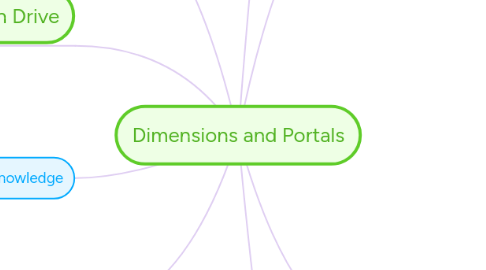
1. Process
1.1. When the idea has been shaped into a better format, a process of communicating your idea falls under the process. The process is the creating phase, whether I am learning a new technique or I am following on from a particular technique and hopefully evolving the process into something new something different
2. The Passion Drive
2.1. Using the theme Dimensions and Portals was part of a passion I had as a kid, the possibilities of 'what if'
2.2. Exposure to Books, Movies and other vehicles that enhances the 'possibilites'
2.3. Keywords: Ideas, Thoughts, Knowledge, Research, Questions
3. Knowledge
3.1. Collecting information surrounding Dimensions and Portals
3.2. Fictional stories based on 'theme' the writers influences and their passion possibly connect them to non-fictional information
3.3. Research on Scientific methods used by Physics, Quantum Physics, a timeline of evolutionary scientific measures
4. Influences
4.1. Artists, writers, scientists, engineers ANYTHING that helps support your idea and or theme fall into this category. Having a list of influences helps shape your processes IF some have used it in their response whether written, sung, painted anything.
5. An Idea
6. The Passion Drive Unpacked
6.1. What
6.2. Where
6.3. Why
6.4. How
6.5. When
7. Research Method
8. Knowledge
8.1. Multiple Worlds - Multiverse Theory - H.G Wells 'The Door in the Wall' published in 1895 (Science Fiction)
8.1.1. Articles
8.1.2. Newspapers (Old)
8.1.3. Books
8.2. 1950's Princeton Unversity graduate Huge Everett reinstates this idea 'The universe at any given moment divides into countless similar instances
8.2.1. Articles
8.3. 1980s - Andrei Linde, scientist develops the theory of multiple universes
8.3.1. Articles
8.3.2. Book
8.4. Professor Stuart Hameroff believes the human brain is the perfect quantum computer, and the soul, or consciousness, is simply information stored at the quantum level
8.4.1. Academic papers
8.4.2. Articles
8.4.3. Books
8.5. Sir Roger Penrose, British physicist and an expert mathematician also supports the theory.
8.5.1. Achievements
8.5.2. Articles
8.6. Biocentrism: How Life and Consciousness Are the Keys to Understanding the Nature of the Universe - Robert Lanza
8.6.1. Book
8.7. Tie into fictional stories such as 'Alice in Wonderland, Coraline and other fictional stories, you may possibly see a relativity between what is fiction and what is non-fiction. The line in-between can become slightly grey or non-existence, it depends on your perceptiveness, it also depends on the advance technological world we are continuing evolving into. At such a fast rate.
8.7.1. Fiction stories
8.7.2. Movies
8.7.3. Children imaginative stories
9. Influencers
9.1. Len Lye - Artist (Who had a passion for scientific knowledge
9.1.1. His passion of science studies and why
9.1.2. Kinetic Art
9.1.3. Sculpturals
9.2. Paul Nylander - Maths, physics and artist
9.2.1. His perfect percision in mathematical formulas to create 3d design model utilising shadow art
9.3. Don Davis - Astrogeologist illustrator, model building, visual special effects, emmy for PBS series Cosmo
9.3.1. Interpret space visionary through data and description to translate into a visual platform for others to understand
9.4. Mark Garlick - Earth science, astronomy, space and science astrophysics. Self taught illustrator and Astronomical Artist
9.4.1. Same as above
9.5. Memo Akten - Interests in science, technology, culture, tradition and religion, algorithms and software. PHD in artificial intelligence, artistic expressive human - machine
9.5.1. The ability to find relativity amongst his passions and his works
10. Process
10.1. 3D modelling software - Maya, AutoCAD, Zbrush, Sculptris
10.2. Visual effects - After Effects, trapcode
10.2.1. Music visualisation
10.2.2. Lighting effects
10.3. Works in spaces
10.3.1. Archetectual designs
10.3.1.1. Pillars
10.3.1.2. Carvings
10.3.1.3. Origami
10.4. Projection mapping
10.4.1. White surfaces
10.4.2. Buildings, new or historical
10.5. Augmented Reality
10.5.1. Photography
10.5.2. Animation creation
10.5.2.1. Animator
10.5.2.2. 3D model - animation
10.5.2.3. Adobe Animate
10.5.2.4. Photoshop
